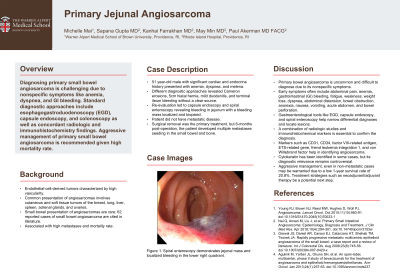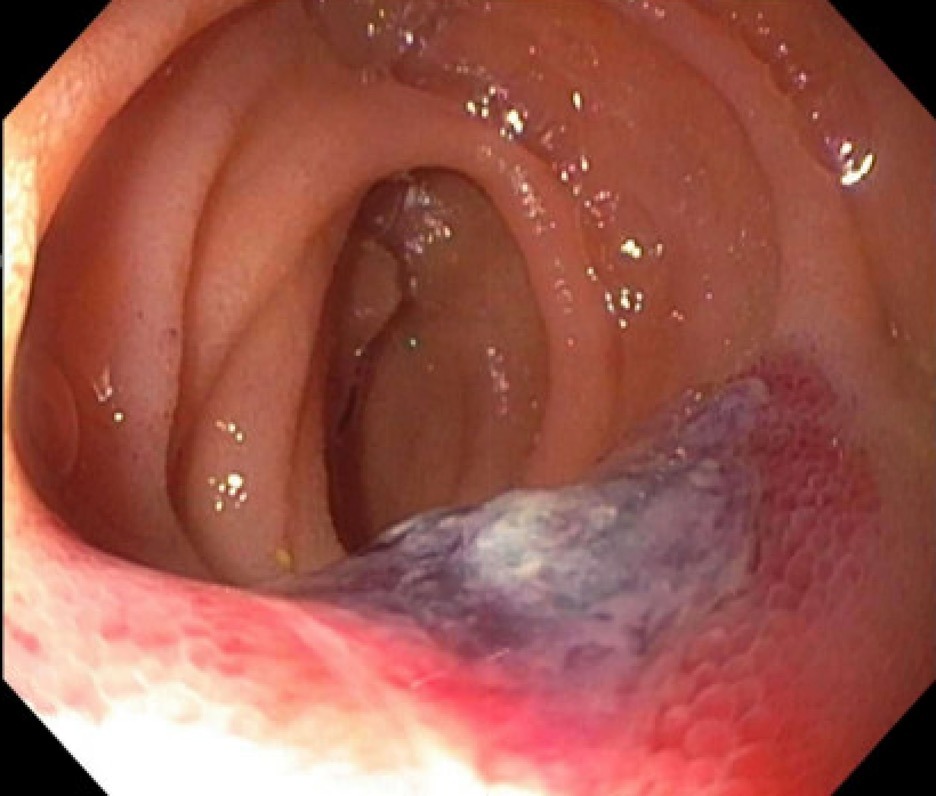Sunday Poster Session
Category: Small Intestine
P1574 - Primary Jejunal Angiosarcoma
Sunday, October 27, 2024
3:30 PM - 7:00 PM ET
Location: Exhibit Hall E

Has Audio

Michelle Mai, BS
Brown University / Warren Alpert Medical School
Providence, RI
Presenting Author(s)
Michelle Mai, BS1, Sapana R. Gupta, MD2, Kanhai Farrakhan, MD2, May Min, MD2, Paul Akerman, MD, FACG2
1Brown University / Warren Alpert Medical School, Providence, RI; 2Brown University / Rhode Island Hospital, Providence, RI
Introduction: Angiosarcomas are aggressive, endothelial-cell-derived tumors characterized by high vascularity and poor prognosis. Most common presentation involves cutaneous and soft-tissue tumors primarily originating from the breast, lung, liver, spleen, adrenal glands, and ovaries. Primary gastrointestinal angiosarcoma is rare and difficult to diagnose, often in resulting metastases and high mortality.
Case Description/Methods: A 51-year-old male with a past medical history of coronary artery disease and diabetes presented with anemia and dyspnea. Initial evaluation revealed troponin elevation (524 ng/L) and severe anemia (hemoglobin 6.2 g/dL). The patient developed melena which prompted an EGD. Endoscopy revealed small Cameron erosions, a hiatal hernia, and mild duodenitis but no active bleeding. A colonoscopy was then performed, revealing no colonic etiology, only blood in the terminal ileum without a clear source. The patient then underwent further evaluation with capsule endoscopy which showed bleeding in the jejunum. A spiral enteroscopy localized a bleeding jejunal mass which upon biopsy was consistent with angiosarcoma. Staging imaging with CT of the abdomen and pelvis was negative for metastasis. The patient underwent laparoscopic resection of the affected portion of the small bowel and lymph node dissection was negative for nodal involvement. Six months post-surgery, surveillance imaging was obtained with a PET scan and multiple areas of metastases were detected in the small bowel and bone.
Discussion: Diagnosing primary small bowel angiosarcoma is challenging due to nonspecific symptoms like anemia, dyspnea, and GI bleeding. Standard diagnostic approaches include EGD, capsule endoscopy, and colonoscopy as well as concordant radiologic and immunohistochemistry findings. Aggressive management of primary small bowel angiosarcoma should be considered 1-year survival can be as low as 20.8%. The efficacy and role for neoadjuvant/adjuvant chemotherapy and new drug interventions will be an important area of future study.

Disclosures:
Michelle Mai, BS1, Sapana R. Gupta, MD2, Kanhai Farrakhan, MD2, May Min, MD2, Paul Akerman, MD, FACG2. P1574 - Primary Jejunal Angiosarcoma, ACG 2024 Annual Scientific Meeting Abstracts. Philadelphia, PA: American College of Gastroenterology.
1Brown University / Warren Alpert Medical School, Providence, RI; 2Brown University / Rhode Island Hospital, Providence, RI
Introduction: Angiosarcomas are aggressive, endothelial-cell-derived tumors characterized by high vascularity and poor prognosis. Most common presentation involves cutaneous and soft-tissue tumors primarily originating from the breast, lung, liver, spleen, adrenal glands, and ovaries. Primary gastrointestinal angiosarcoma is rare and difficult to diagnose, often in resulting metastases and high mortality.
Case Description/Methods: A 51-year-old male with a past medical history of coronary artery disease and diabetes presented with anemia and dyspnea. Initial evaluation revealed troponin elevation (524 ng/L) and severe anemia (hemoglobin 6.2 g/dL). The patient developed melena which prompted an EGD. Endoscopy revealed small Cameron erosions, a hiatal hernia, and mild duodenitis but no active bleeding. A colonoscopy was then performed, revealing no colonic etiology, only blood in the terminal ileum without a clear source. The patient then underwent further evaluation with capsule endoscopy which showed bleeding in the jejunum. A spiral enteroscopy localized a bleeding jejunal mass which upon biopsy was consistent with angiosarcoma. Staging imaging with CT of the abdomen and pelvis was negative for metastasis. The patient underwent laparoscopic resection of the affected portion of the small bowel and lymph node dissection was negative for nodal involvement. Six months post-surgery, surveillance imaging was obtained with a PET scan and multiple areas of metastases were detected in the small bowel and bone.
Discussion: Diagnosing primary small bowel angiosarcoma is challenging due to nonspecific symptoms like anemia, dyspnea, and GI bleeding. Standard diagnostic approaches include EGD, capsule endoscopy, and colonoscopy as well as concordant radiologic and immunohistochemistry findings. Aggressive management of primary small bowel angiosarcoma should be considered 1-year survival can be as low as 20.8%. The efficacy and role for neoadjuvant/adjuvant chemotherapy and new drug interventions will be an important area of future study.

Figure: Spiral enteroscopy revealed a large, ulcerated mass with bleeding in the mid-jejunum, later confirmed as primary small bowel angiosarcoma.
Disclosures:
Michelle Mai indicated no relevant financial relationships.
Sapana Gupta indicated no relevant financial relationships.
Kanhai Farrakhan indicated no relevant financial relationships.
May Min indicated no relevant financial relationships.
Paul Akerman indicated no relevant financial relationships.
Michelle Mai, BS1, Sapana R. Gupta, MD2, Kanhai Farrakhan, MD2, May Min, MD2, Paul Akerman, MD, FACG2. P1574 - Primary Jejunal Angiosarcoma, ACG 2024 Annual Scientific Meeting Abstracts. Philadelphia, PA: American College of Gastroenterology.
